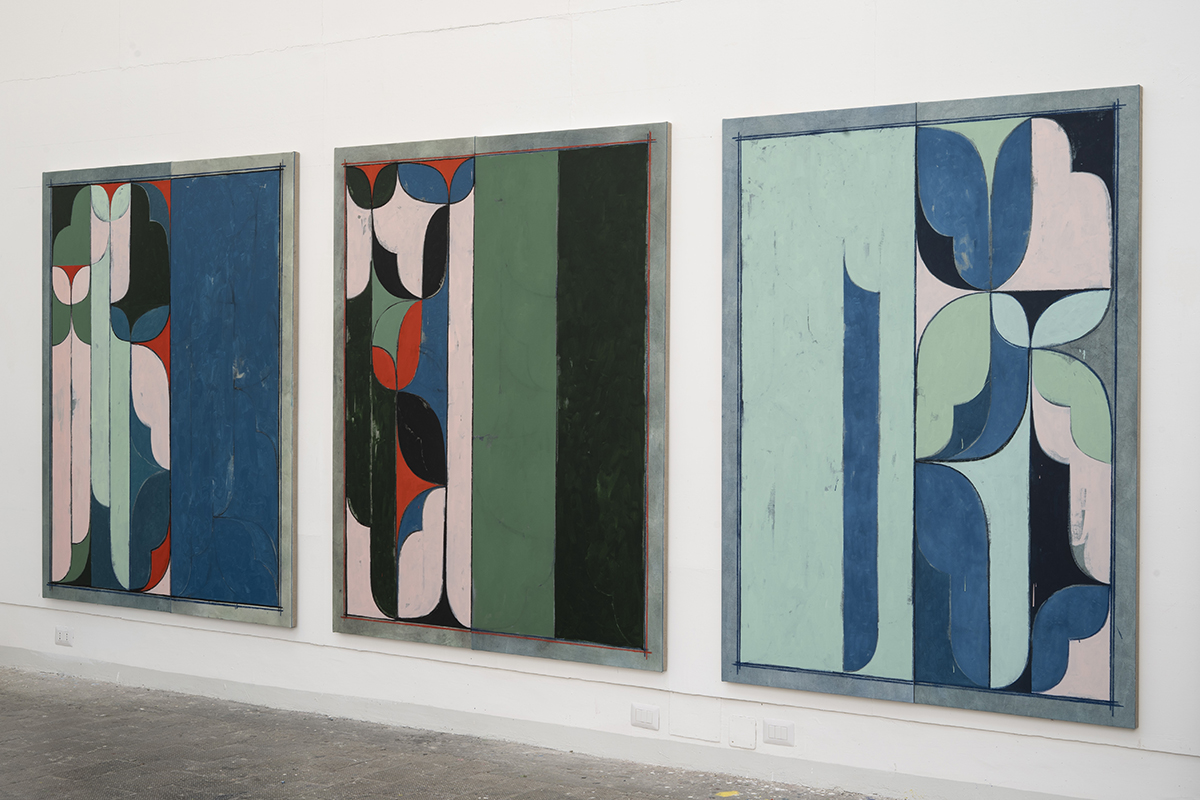The Brooklyn-based artist Kamrooz Aram is the 2024 Carla Fendi Rome Prize Fellow. His Rome Prize project at the Academy, Renegotiating Ornament, emphasizes research in architectural and decorative painting traditions on the Italian peninsula, from fresco to faux marble, along with decorative practices using mosaics, terrazzo, marble, and other materials. Some of these traditions were influenced by Islamic art and architecture, and Aram is interested in how this influence disrupts a Eurocentric understanding of the art-historical canon.
Born in Shiraz, Iran, Aram has had work exhibited internationally, including at Peter Blum Gallery, the Arts Club of Chicago, FLAG Art Foundation, Green Art Gallery, the Modern Art Museum of Fort Worth, the Atlanta Contemporary, and the Museum Dhondt-Dhaenens, among other venues. This summer, Aram has work in Expodemic: Festival of Foreign Academies and Cultural Institutes at Palazzo delle Esposizioni in Rome.
AAR spoke to Aram about his ongoing fellowship.
What have you been working on while at AAR? Has your project changed since arriving?
It took me a while to get settled here with materials, but I finally managed to do this as the days started to get longer and the natural light in my studio exceeded my expectations. I have been thinking a lot about the intertwining histories of architectural painting and portable painting (i.e., frescoes, etc. versus canvases and panels). The first thing I made when I arrived in Rome was a small painting on unstretched, raw linen to hang on the empty walls of my room at the Academy. This portable form of painting was a nod to Giorgio Griffa, whose paintings are made on raw, unstretched linen, and are folded neatly like a tablecloth for transportation.
Recently I completed a series of new works for an exhibition at the Palazzo delle Esposizione in Rome. This presentation includes three diptych paintings, as well as three sculptures and a wall painting. The wall painting is made with Venetian plaster, a form of decorative/architectural painting that I have not had the opportunity or resources to explore before. Now that the exhibition has opened, I am happy to be back in the studio with no expectations at all, allowing the work to develop slowly and organically.

What’s something that has surprised you about being at the Academy?
My own adaptability has surprised me here. The communal environment was initially challenging for me, as I am a very private person. But I was surprised at how adaptable I was, and that I found freedom in embracing the unexpected. The disruption of my daily habits and my studio routine, which had been established steadily in Brooklyn for twenty-plus years, is one of the things I have come to value the most about being here.
I was also surprised by the support I received here from the staff, especially when it comes to sourcing materials, fabricators, and even helping with communication and translation with the various vendors. Everyone—from the administrative offices to the cleaning staff—is genuinely invested in making this a meaningful experience for the fellows.
Have you had any great conversations with other fellows or residents that changed your perspective?
I have meaningful conversations with other fellows every day. It is a very intellectually generous environment. The conversations I value the most are the ones that happen organically, some of which develop slowly over the weeks. When you are here for so long, there is no urgency to have a meaningful conversation at every meal. Once that pressure is removed, that’s when the most meaningful conversations happen. But I also appreciate the conversations that have nothing to do with our work. Those conversations are just as valuable to me.
What have you seen in the city of Rome that has made a strong impression on you?
It is both cliché and true to say that Rome is a palimpsest of civilization. While the city can be easily read as a unified whole, to see the architecture in a single, even layer, it is fascinating to separate the layers and observe the centuries of appropriation piled upon one another. It can be difficult to truly feel this history because Rome is also an outdoor museum, packed full of tourists. But when you spend time away from the most popular tourist sites, and as you pass the same ancient walls daily, you begin to understand that the city is very much alive and that Romans live in and among these layers of history without overt veneration.
